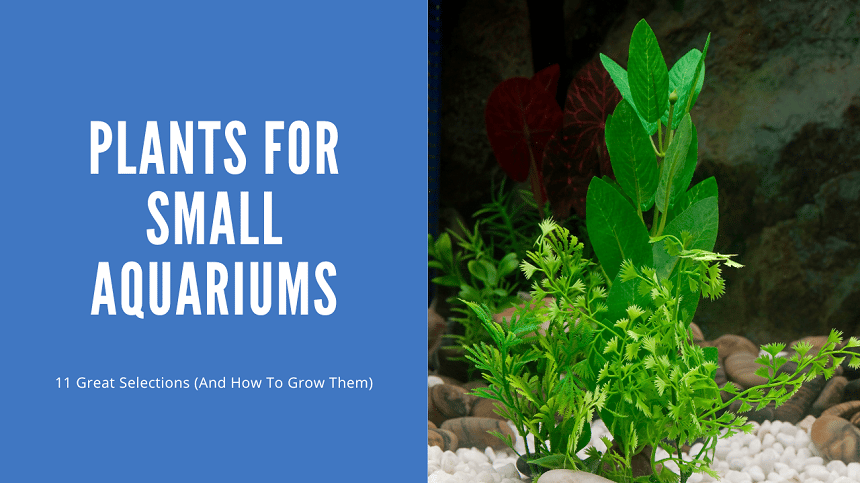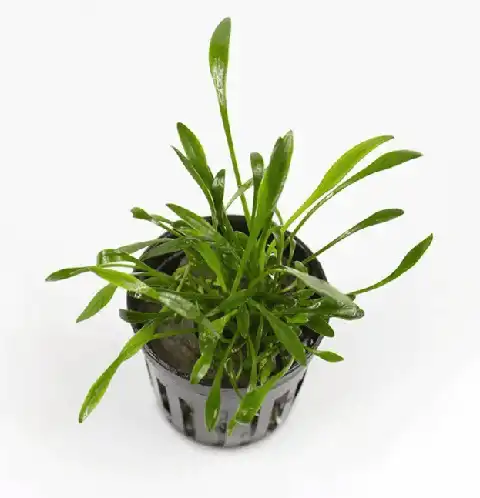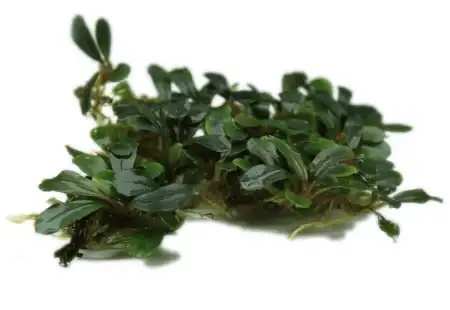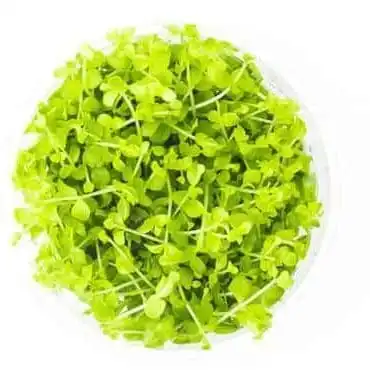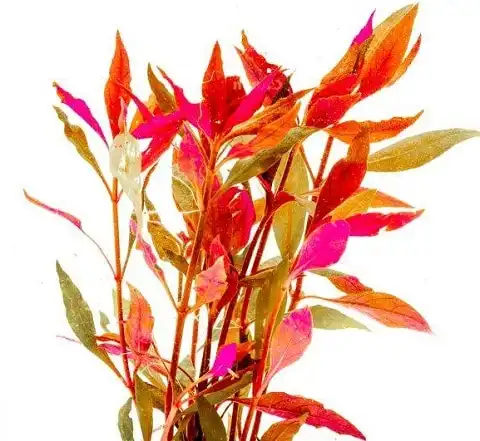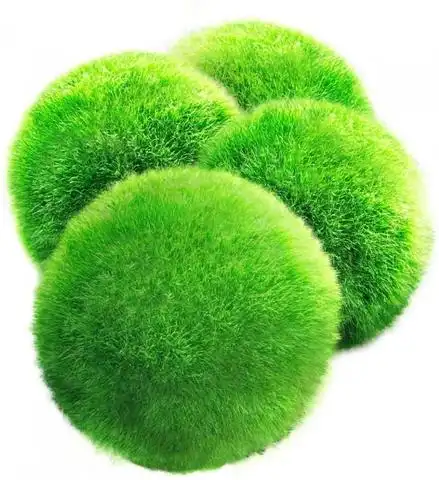Thank you for visiting! By the way… any links on this page that lead to products on Amazon and other stores/partners are affiliate links Aquarium Store Depot earns a commission if you make a purchase.
Designing a planted aquarium is one of the best things you can do for your fish. Apart from enhancing the beauty of your tank, freshwater aquarium plants are excellent at boosting the oxygen levels of a fish tank.
As a beginner, finding suitable plants for a small tank can be challenging and extremely time-consuming. You can find yourself grappling with looking for the perfect aquarium plants and valuable techniques to arrange them in a small aquarium.
But don’t worry! This article is going to be one of the best sources for discovering aquarium plants with everything you need to know. Let’s figure out what the best plants for small aquarium are.
What Are They?
Aquarium plants are can be aquatic or live out of the water. They can be used as natural filters in an aquarium and when planted correctly, can create incredible aquascapes that look like underwater gardens.
It doesn’t matter whether you run a nano tank or keep a community aquarium, toxins are faster at blowing up in the tank than you imagine. To connect your fish to a healthy environment, devoid of toxins and stress resulting from debris, you need some good aquarium plants and regular maintainance.
Aquarium plants are also used to prevent excessive algae growth. But it’s quite fascinating to know that there are more advantages to getting plants than the ones you’ve heard and read about.
Pro Tip: To determine what looks best in what place, use the shortest plants in the foreground with the largest aquarium plants used as the background plants
The Benefits
The benefits live aquarium plants bring are great. Aquarium plants are perfect to boost oxygen, consumer nutrients toxins like nitrate, and manage the dietary needs of fish.
They can also help with controlling algae growth and maintain an overall well-balanced ecosystem. But these are not the only advantages which they bring along. You get a long list of benefits of using freshwater aquarium plants I’m going to chalk out right away.
Cleaning Water
By producing oxygen and absorbing CO2, freshwater aquarium plants are perfect to introduce throughout aquarium tanks.
Fish waste can be extremely toxic for your freshwater fish species, but there are nutrients found in the fish debris that the plants use to control algae growth and complete the nitrogen cycle.
Shade
If you have a small aquarium and using too many caves can be challenging, aquarium plants are for you.
Depending on the size of your aquarium, some plants can work as a shield against stress and aggressive fish species. Since some fish species tend to shy away from social gatherings and prefer living in hideouts, you can use aquarium plants so your pet can feel comfortable and safe under their shade.
Source Of Food
A planted aquarium can be a great source of healthy food for your pet. Instead of looking constantly for expensive and new variations in their diet, you can supplement their menu with live plants.
Aquarium Beauty
Aquarium plants make your tank much more appealing and maintained. They can lace it with a natural look for both you and your fish to enjoy.
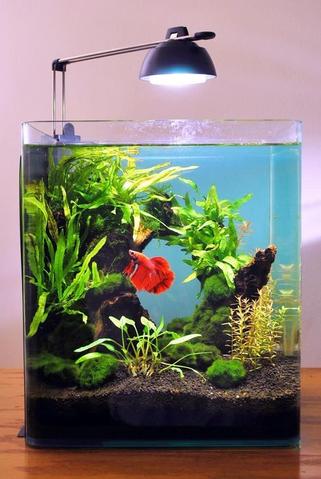
Other than that, planted tanks are one of the best assets to fish during the spawning seasons. Most fish species will always go for plants to establish spawning sites and create a wonderful refuge for newly hatched fry.
11 Best Plants For Small Aquariums
It’s time to dive into the 11 best types of aquarium plants you can get for your small, risk-free aquarium. You can check out the video below from our YouTube channel to follow along. We go over in more detail in the blog post below. Please subscribe to our channel if you like our content!
I will pen down the following information for each type so you can learn everything in detail.
- Scientific Name
- Common Name
- Origin
- Skill level
- Lighting
- Temperature Range
- Flow Rate
- CO2 requirement
Let’s go over our list…
1. Anubias Nana Petite
Anubias nana petite is the smallest Anubias available in the aquarium trade. Has the ability to grow like a carpet in the right conditions
- Scientific Name: Anúbias bárteri var. nána (Engler) Crusio
- Common Name: Anubias Nana Petite
- Origin: West Africa
- Skill level: Easy
- Lighting: Medium
- Temperature Range: 72 F° to 82 F°
- Flow Rate: Low to moderate
- CO2 requirement: Not necessary
As a beginner aquatic with a small tank, Anubias Nana Petite can be one of the best choices you can make. The plant does well in freshwater aquariums and can easily withstand environmental changes.
Since it’s essential to make your aquarium look natural, the green-colored and tiny leaves of this plant can help you achieve that goal.
Anubias Nana Petite is one of the best foreground plants that should be attached to the base of the hardscape around the mid-ground area. You can refer to this plant as a carpeting plant that ranks as one of the smallest Anubias Plants in the aquarium hobby.
The low maintenance of Anubias Nana Petite makes it perfect for novices, but make sure you pay attention to its rhizome. The rhizome should stay above the substrate, and the plant should be exposed to low light to grow. It usually grows slowly so don’t lose your patience.
2. Cryptocoryne Parva
Parva is one of the smallest Cypt plants available in the aquarium trade. A slow grower
- Scientific Name: Cryptocoryne parva
- Common Name: Dwarf Water Trumpet
- Origin: Sri Lanka
- Skill level: Easy
- Lighting: Low
- Temperature Range: 73 F° to 82 F°
- Flow Rate: Low to moderate
- CO2 requirement: Not necessary
Originating from Sri Lanka, Cryptocoryne Parva is now known as one of the best aquatic plants around the world.
Depending on cultivation, Cryptocoryne Parva stays the same in coloration. A good thing about this plant is that it is small and worth your investment.
Compared to other Cryptocoryne plants, this one needs more lighting to grow leaves underwater. The plant can shed leaves as a natural process called Crypt Melt when placed in freshwater home aquariums, but that’s natural. Once the plant gets familiar with the new environment and is placed under bright natural lighting, you will see it regrowing leaves in no time!
Like Anubias Nana Petite, this is another great foreground plant on the list. The leaves of a Cryptocoryne Parva look similar to grass and grow wide above the water but narrow underwater.
3. Dwarf Hairgrass
Dwarf hairgrass is an easy to grow carpet that is great for beginners. Purchase tissue culture plants to ensure pest free plants!
- Scientific Name: Eleocharis parvula
- Common Name: Dwarf Spikerush, Small Spikerush, Dwarf Spike Rush
- Origin: North America
- Skill level: Easy
- Lighting: Moderate
- Temperature Range: 70 F° to 83 F°
- Flow Rate: Moderate to fast
- CO2 requirement: Yes
Dwarf Hairgrass is pretty easy to manage given you take care of water parameters and other important elements of their basic care sheet. It is another foreground plant that you can include in some of the best carpet plants suitable for a small fish tank.
This plant grows like aquatic grass across freshwater tanks with slim stalks looking like roots. The stalks grow horizontally and can give your tank a natural look.
Dwarf Hairgrass can help you provide shelter to your bottom dwelling fish and spread out to make great ground cover. The hardy nature of a Dwarf Hairgrass makes it perfect for beginners.
4. Bucephalandra
Bucephalandra is a slow-growing plant that's perfect for anyone looking to grow their first aquatic plant. They are great for attaching to hardscape
- Scientific Name: Bucephalandra spp.
- Common Name: Buce Plant, Buceps
- Origin: Borneo, Southeast Asia
- Skill level: Easy
- Lighting: Low
- Temperature Range: 71 F° to 79 F°
- Flow Rate: Moderate to high
- CO2 requirement: No, but recommended
With different variates, Bucephalandra is another great option to consider.
Similar to Anubias and Cryptocoryne discussed above, Bucephalandra is also found in rapidly moving waters. With almost 150 years old, a Bucephalandra is considered now a top choice of small aquariums. The plant goes through climate change throughout the year. To give you a good estimate of its temperature tolerance, keep the plant water that’s between 71 F to 79 F.
This plant can be relatively hard to find in a local fish store as compared to other plants. The plant displays vivid colored leaves and rhizomes that appear more in line.
Here are two varieties of Bucyphalandra I’ll discuss in this article.
1. Bucyphalandra Mini Coin
Buce Mini Coin is another aquarium plant that is pretty simple to care for. The plant grows tiny green leaves and sits perfectly as a foreground plant. But It takes the plant a considerable time to grow. And due to slow growth, you might find it demanding to stay patient and see the magic of it.
Bucephalandra plants are unique to find, and on top of that, this variation is even harder to get your hands on. But since you have a small tank, this plant can is perfect for you.
2. Bucyphalandra Arrogant Blue
This aquarium plant is another beautiful variation of Bucephalandra plants. Perfect for new aquarium owners, the plant leaves look round with a prominent center vein. Even though the mature leaves are deep green, you can see shades of blue on the new leaves. Another thing that might strike your attention is the white dots visibly scattered across the new leaves.
This beautiful plant is good to place in a nano aquarium or a layout that comprises small details.
5. Christmas Moss
A easy to care ground cover plant that is an excellent choice for shrimp tanks
- Scientific Name: Vesicularia montagnei
- Common Name: Christmas Moss, Brazillian Willow Moss, Xmas Moss
- Origin: Southeast Asia
- Skill level: Easy
- Lighting: Moderate
- Temperature Range: 72 F° to 82 F°
- Flow Rate: Low to moderate
- CO2 requirement: No, but recommended
Since we are covering plants that can grow in a small aquarium, here’s another plant on the list called Christmas Moss that can make your planted tank sufficient for your fish.
Christmas Moss is one of the most commonly used plants in the aquarium hobby. Despite having a slow growth rate, it creates a field across your tank and can be used as moss by your fish during spawning. You can also use this plant to provide a valuable hiding place for your fish and a source of food for small fish species and invertebrates.
The plant resembles the shape of a Christmas tree because of its branches that droop and overlap each other. Christmas Moss might also look similar to Java Moss but there’s a considerable difference between the plants.
Author's Note: Christmas Moss grows well when put completely under water. Due to its versatility, the moss can grow on land as well as on rocks and branches. It will grow faster out of water!
6. Micranthemum ‘Monte Carlo’
Tissue culture plants are grown in labs and are completely pest free and have great shelf lives
- Scientific Name: Micranthemum tweediei
- Common Name: Monte Carlo
- Origin: Argentina
- Skill level: Easy to moderate
- Lighting: Medium
- Temperature Range: 68 F° to 77 F°
- Flow Rate: Moderate
- CO2 requirement: Yes
The Monte Carlo, scientifically classified as Micranthemum, is a magnificent carpeting plant that gives a velvety touch to the base of your aquarium.
Found in streams and lakes, the plant is now a popular plant around the world.
The plant has a moderate growth rate, and if managed properly, it can spread quickly, creating a silky mat across your planted tank. Since it grows laterally, you can see small bright green-colored leaves popping out.
The unique trait of Monte Carlo is that it can grow along the bottom but you can also use cuttings to create a cascade over the rocks.
7. Staurogyne Repens
Staurogyne Repens is a low-growing aquatic plant with small light green leaves. It's a stem plant that will grow in few inches in height
- Scientific Name: Staurogyne répens (Nees) Kuntze
- Common Name: Staurogyne Repens
- Origin: South America
- Skill level: Moderate
- Lighting: Moderate to high
- Temperature Range: 68 F° to 86 F°
- Flow Rate: Moderate
- CO2 requirement: Yes
best aquarium plants dense carpet water column beautiful plants ground cover enriched substrate baby tears leaf shapes baby shrimp breeding tank liquid fertilizer stem plant Amano shrimp tanks nano plants marimo moss ball background plant stem plants
Staurogyne repens is one of the best foreground plants for a nano aquarium. This is not a difficult plant to care for. In fact, this is quite a hardy plant that you can easily manage as a beginner.
Staurogyne repens gives a fresh greenish look to the aquariums. Under bright light, the plant can grow long and upright shoots. It’s better to place this aquarium plant under low light and let it grow gradually and colonize the gravel at its own pace. This plant, like other mid ground plants, can be placed in the middle ground of the aquarium.
Staurogyne repens grow horizontal shoots as soon as you cut the upright and longest shoots. And due to the fast growth of the plant, it’s recommended to maintain low density. You can do this by letting the emergent leaves die under the water.
8. Helanthium Vesuvius
Featuring vibrant green leaves with a unique curling growth pattern, Helanthium Vesuvius makes a great addition to any freshwater setup.
- Scientific Name: Helánthium boliviánum (Rusby) Lehtonen & Myllys
- Common Name: Echinodorus Vesuvius
- Origin: Singapore
- Skill level: Easy
- Lighting: Medium
- Temperature Range: 50 F° to 86 F°
- Flow Rate: Moderate to fast
- CO2 requirement: Not necessary
Helanthium Vesuvius or famously known as Vesuvius Sword Plant is a relatively new plant to the aquarium hobby. With its usual ability to grow leaves in a way that makes them appear projecting from the plant base like a spiral sword, this plant is a perfect fit for a nano aquarium.
The plant typically grows above the water, hence, it can grow wider leaves above the water level. Apart from this, you can also see flower buds appearing out of nowhere. For a beginner, this plant is a good option to consider. Due to the large size, you can use Helanthium Vesuvius as a background plant for your nano tank.
9. Sagittaria Subulata
Sagittaria Subulata is an easy-to-care-for plant that can add subtle depth and beauty to your aquascape. It is a great plant for beginners because it is low-maintenance and can be grown emersed or submersed.
- Scientific Name: Sagittaria Subulata L.
- Common Name: Arrowhead, Awl-leaf, Narrow-leaved Arrowhead, Dwarf Sagittaria
- Origin: South America
- Skill level: Easy
- Lighting: Low
- Temperature Range: 59 F° to 84 F°
- Flow Rate: Moderate to high
- CO2 requirement: Yes
Sagittaria Subulata is a pretty easy-to-care and one of the best beginner aquarium plants that you can place with one of your foreground plants in your tank.
The reason I put this one on the list is the beautiful and uniquely designed leaves of this plant that look like a ribbon. Despite getting taller with time, the plant is still a good species for beginners to try out. It can withstand shifting water parameters, given you provide it with good natural lighting.
Observing its appearance, you will see the plant resembles grass. It is not a slow-growing plant. In fact, under certain conditions, it can grow up to 50cm long. Apart from this, Sagittaria Subulata can grow a long flower stem to the water surface and sometimes above that with tiny flowers appearing right above the waterline.
One of the unique traits of this plant is that it can also grow thick clusters which can be slightly demanding to handle. To control the plant from growing thick groups and to keep the carpet to a moderate length, remove runners with longer leaves now and again.
Pro tip: Sagittaria Subulata is already a fast-growing plant. Use of Carbon Dioxide since it can trigger growth that can make this plant highly demanding to handle.
10. Alternanthera Reineckii ‘Mini
The smallest variant of the AR Rosaefolias. Requires medium to intense lighting and CO2 injection
- Scientific Name: Alternanthera Reineckii
- Common Name: Rosaefolia minor, AR mini
- Origin: South America
- Skill level: Moderate
- Lighting: Moderate
- Temperature Range: 73 F° to 80 F°
- Flow Rate: Low
- CO2 requirement: Yes
If you’re looking for something unique in appearance, then give AR Mini a try.
This is a dwarf variant of the well-known plant species Alternanthera Reineckii. It is a perfect fit for nano aquariums but you can also use it for a large tank.
Since it’s a stem plant, you have to give it a good amount of light to properly grow. Giving CO2 can also help it hit the optimum growth mark.
The plant has poor tolerance for disturbed water parameters so it’s recommended to avoid drastic changes.
It’s one of the very few foreground plants that has a bright red appearance. You can create a dense carpet by making partial trimmings.
11. Moss Balls
Budget Option
A cheap and easy to care for aquarium plant. Thrives in low light and very low maintenance
- Scientific Name: Aegagropila linnaei
- Common Name: Moss balls, Lake balls, Cladophora ball
- Origin: Northern Europe and Japan
- Skill level: Easy
- Lighting: Low to medium
- Temperature Range: 72 F° to 78 F°
- Flow Rate: Low
- CO2 requirement: Yes
These little green balls are not moss, but algae that look incredible in small tanks. The fascinating thing about the marimo moss ball is that the action of waves helps it keep its round shape intact. In the wild, these moss balls thrive in cold water, making it slightly endangered species to house in home aquariums.
To get the best out of them, get those moss balls that were cultivated using environment-friendly methods. For a beginner, Moss balls are pretty easy to care for. But you have to consider a few things to ensure they survive.
Unlike other more resilient plants, Moss balls have to be placed in cool water so that they can live longer.
You should always keep them in an area where the sunlight doesn’t fall directly on them. Too much light or inadequate lighting are both dangerous to this species. They can turn brown if the light is too bright or too low. Things like going out of shape can happen as a result. You have to make the water move so it can melt back to its original shape.
Apart from this, these algae balls need fertilizers for proper growth. They grow slowly but once they get their preferred conditions in a home tank, these moss balls can grow up to 12 inches.
FAQS
How do you grow plants in a small fish tank?
There are a lot of factors that determine the potential of growing plants in a home aquarium. Probably the most contributing factor is proper lighting. Plants need at least 8 hours of sunlight to grow into strong plants.
Things like deep filtration, water temperature, acidity levels, substrate, Carbon Dioxide, and how well you plant them also matter. You should also consider fertilizer for carpet plants since plants gather nutrients from it.
How can I keep my fish tank plants short?
Ground-covering plants can sometimes grow too big to manage in a small tank. To prevent unnecessary growth, trim your plants regularly. Make sure you cut the upper shoots a few centimeters using Wave Cutters. You can also use Spring Scissors designed specifically for trimming plants.
What is a plant only fish tank called?
Planted tanks are the type of aquarium setup that allows you to buy, arrange and take care of your favorite plants in a single setting. Like a fish tank that can combine different plants, a planted tank can also have fish, but the main focus remains on plant life.
What are foreground fish tank plants?
Choosing the right plants according to your aquarium size, type and setting are important.
If you are looking for a plant that you can place at the base then foreground plants are perfect for you. Foreground plants are those aquarium plants that you can place at the foot of a hardscape layout or around the middle ground area.
These plants are also known as carpeting plants that grow a field across the aquarium ground and are always pretty small.
Is Anubias a foreground plant?
There are at least 8 different species from the genus Anubias. Some plants are background plants while others are foreground plants. You can also see Anubias plants used for the midground.
Closing Thoughts
While most people think of plants as needing a lot of space, there are actually plenty of varieties that do very well in small aquariums. Many of these plants are also easy to care for and require little to moderate maintenance, making them perfect for beginner aquarists or those who don’t have a lot of time to dedicate to their hobby. If you have any experience keeping small plants in your aquarium, let us know in the comments!
- About the Author
- Latest Posts
I’m thrilled that you found Aquarium Store Depot! Here you’ll find information on fish, aquariums, and all things aquatics related. I’m a hobbyist (being doing this since I was 11) and here to help other hobbyists thrive with their aquariums! I adhere to a high quality Editorial Process and Review products with real life field usage and practical analysis.

